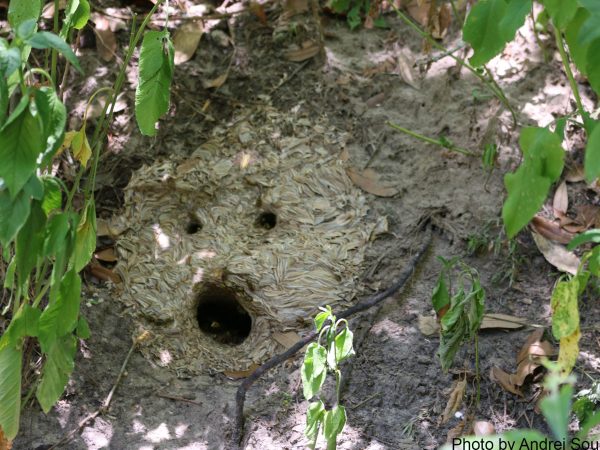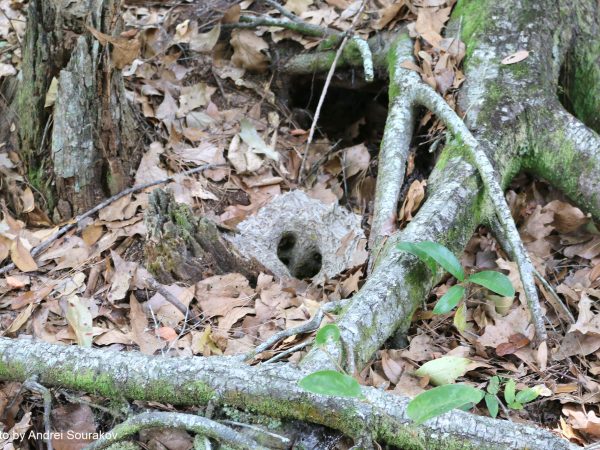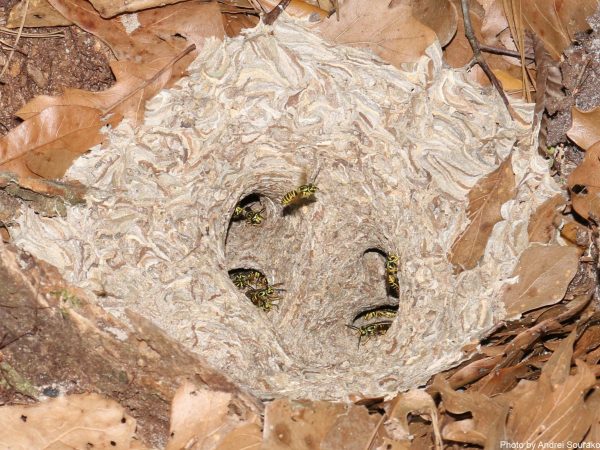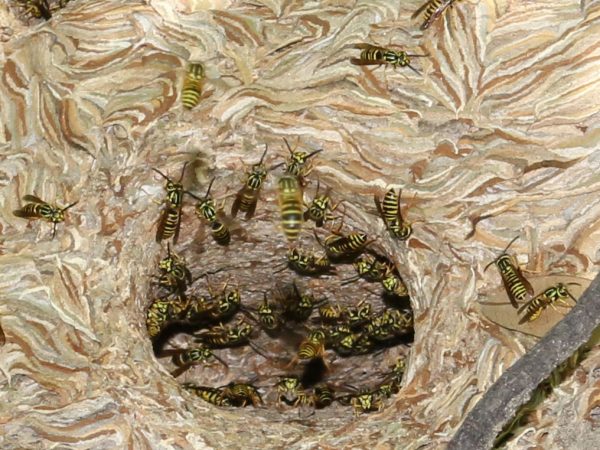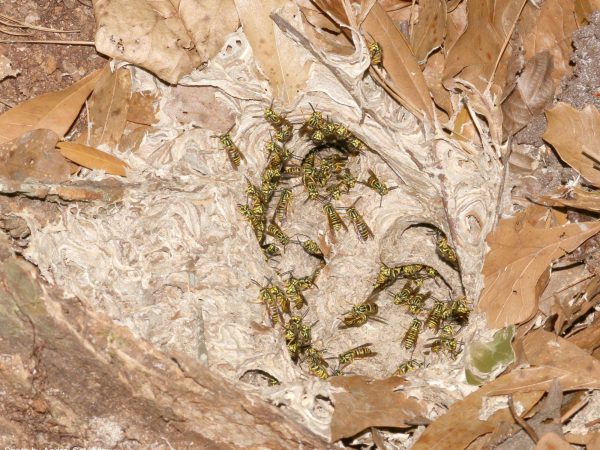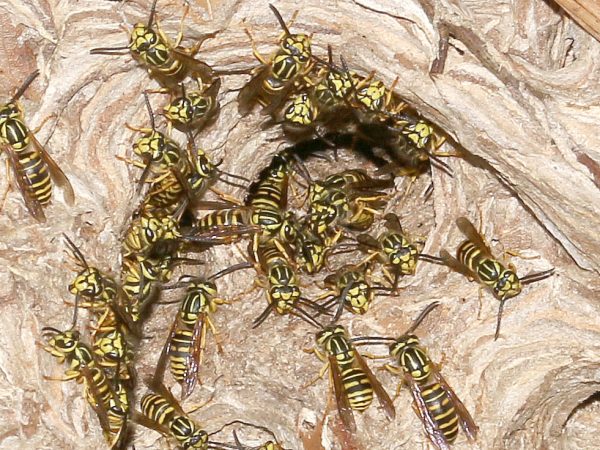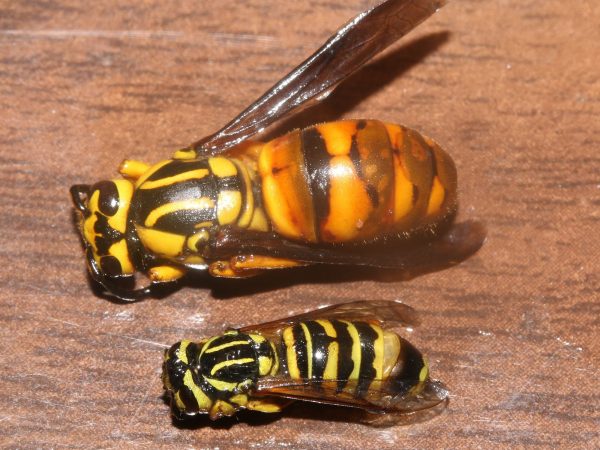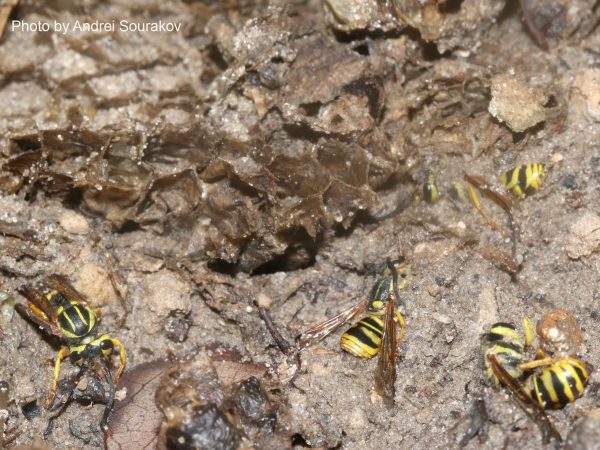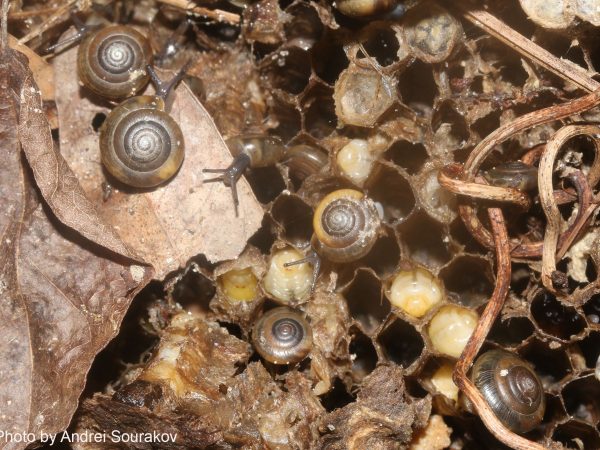I am an entomologist and should know better. But we all, in the field of entomology, have pretty narrow specializations, and social insects are almost as much a mystery to me as they are to the next person.
Last year, during my daily lunchtime walks in the Natural Area behind the Florida Museum of Natural History, I noticed two yellowjacket nests. One was pretty hard to miss – it was located in a hillside, and a stream of wasps came and went, entering it through the mouth- and eye-like openings of this face-like nest. I observed the construction of the nest daily starting about midway through the process, and it was remarkable how much more face-like the nest’s entrance became each time, as if the wasps were guided by the invisible hand of a drunk primitivist artist.
I found the second nest in a much more serendipitous way. I normally sit on the same fallen-tree trunk when lunching, and, on one occasion, noticed that, through a light gap in the dark canopy of the surrounding hardwood hammock, about four yards from where I was sitting, a steady “drip-drip” of insects was silently falling from the sky and disappearing under the roots of a laurel oak. Upon closer examination, I discovered that there was a wasps’ nest with a small entrance located in the leaf litter at the base of the tree. This second nest seemed so peaceful and so cryptic, that I had little fear of someone accidentally discovering it and stepping on it, even though it was no more than 10 feet from the trail. Nevertheless, just to avoid this possibility, I placed some signs next to both nests warning people of their existence.
I continued my weekly visits, filming the progress of nest construction and admiring how quiet and organized the wasps are in their tireless work. At some point, I mentioned this to a retired entomology professor from whom, 30 years prior, I had taken courses in insect ecology. His outlook was surprisingly grim:
“It is life-threatening,” he said. “Exterminators should be called.”
I was taken aback. Aren’t wasps a part of the ecosystem? Aren’t they not bothering anyone and providing herbivore-controlling ecosystem services? Should we mess with natural order of things in an ecosystem and still expect it to function properly? I felt conflicted!
To show the world how peaceful and misunderstood these wasps are, I decided to make a film for Youtube and put their tireless work to some meditative oriental music. I filmed them from not more than three feet away with a hand-held photo camera. They came and went, stumbling into me sometimes, but never seemed to mind me in the least. But I was not satisfied with the results of my efforts – the footage was too wobbly. I decided to set my camera on a tripod right above the nest. On one of my lunch breaks, I crawled with my equipment to the nest and installed it right above the entrance. Then I pressed “record” and stepped back to admire my setup. I was going to let the camera record for 10 minutes – enough, I thought, to make my meditative film from which the world would be able to see what interesting and harmless creatures yellowjackets really are.
The red recording light on the back of the camera was blinking, and all was going according to plan, when I noticed that the incoming wasps were beginning to slow down near the camera and some had even landed on it as if to check it out. The outgoing wasps also began to slow down, and before too long, I realized I had made a mistake:
“You never can tell with bees” of Winnie-the-Pooh suddenly came to mind.
I ran to my office, printed two signs warning the world of “Yellowjacket Danger!” and ran back and “closed” the trail with them. By that time, the swarm of wasps around the camera had grown to about six-feet in diameter. The last hope of retrieving the camera had now vanished, and a thunderstorm was brewing on the horizon, spelling certain disaster for the electronics.
This video shows both nests in their peaceful state, a few shots of immature stages, and dragonflies hunting yellowjackets around the nests (a short clip of wasps attacking the camera is included here and on its own at the end of this post):
Fortunately, it occurred to me that just a year earlier, the Entomology department next door had opened a new honeybee facility. I ran there and – oh, what luck! – found several graduate students having lunch. I hurriedly explained the dilemma to them and they furnished me with an astronaut-like beekeeper’s suit. The dark clouds were gathering and it promised to be a hell of a storm. I put on the suit within viewing distance of the cloud of wasps, which, far from having grown any smaller, had now ballooned to a diameter of 10 feet. At the place where I normally eat lunch by the trail, I had left a plastic bag, and the wasps were vehemently attacking it too. The camera could hardly be seen underneath all the wasps! Invincible in my bee suit, I ran into the wasp cloud, grabbed the camera, and then sprinted away for about 200 yards, until I made sure no wasps were following me. The cryo-freezer gloves with which I had protected my hands allowed me to chase away or kill off the wasps covering the camera.
Needless to say, the footage that resulted from the recording does not meet the standards of the society for improved meditative practices, if such a society exists, but nevertheless is quite educational. My outlook on the hazards of yellowjackets has greatly changed too, to the point that I suggested the removal of both nests prior to summer camp visits to the Natural Area, which were about to start happening soon. I visited the excavated nests the following morning and discovered that both had numerous queens in them that were now scattered about the ground among thousands of worker wasps.
The queens are easily recognizable by their size. They can work together to build a larger nest faster but can also leave the nest to start their own colony. Normally, a nest dies out during the winter, but with winters getting warmer in our parts, these nests were probably the result of several years of colonization and had had time to grow to a pretty large size: the cavities they occupied turned out to be 20-40 gallons in size, with the under-the-tree nest being larger than the one in the hillside.
As they say, “you can’t judge a book by its cover,” to which I might add, “or the wasps’ nest by its entrance.”
I was not stung a single time during my yellowjacket misadventure behind the museum, but the following summer, I ran over a small nest of only a dozen workers plus a queen with a lawnmower in my front yard. This time, the yellowjacket encounter was not as painless – I got stung twice, once on the elbow and once on the side. The sharp pain initially was followed by a swelling that lasted and itched for about a week. It was easy to see what the venerable entomology professor was talking about when he characterized the nests as “life-threatening.”
“Listen to one’s elders,” is another lesson one can draw from this tale; they’ve already made the mistakes you are about to make.
Short clip showing angry wasps attacking the camera:
